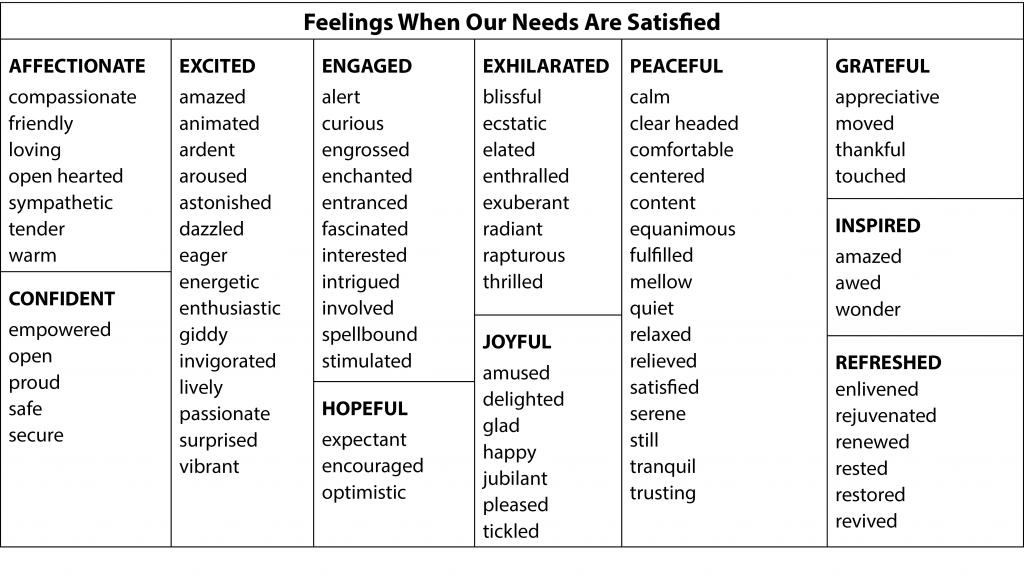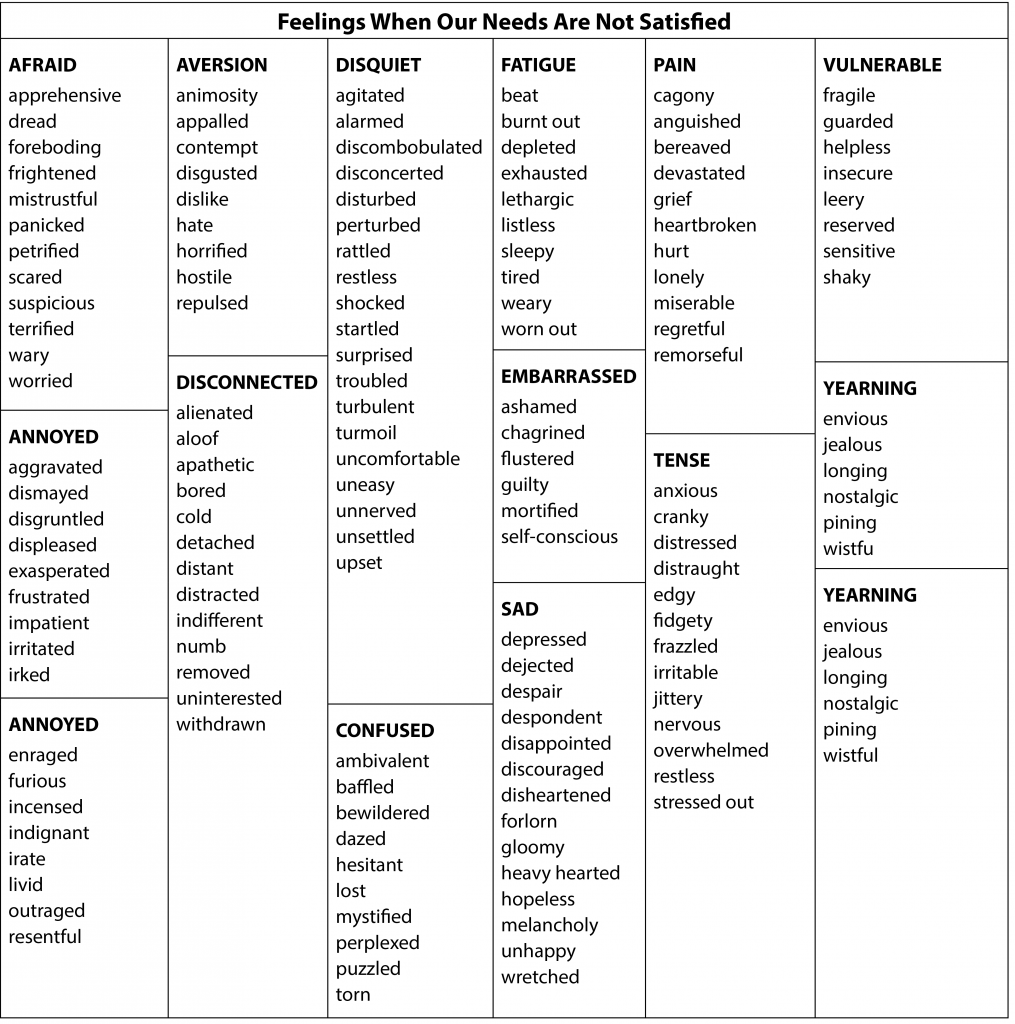Session 3: Values, Committed Action & Collective Empowerment
3.2 Mindfulness Practice: Awareness of Emotions and Human Needs
Learning Objectives:
- To promote connection and group cohesion by means of a mindfulness exercise
- To support participants in focusing on the present moment, and
- To support participants in getting in touch with compassion for self and others
Materials: A mindfulness bell, Resources 3.2.1- Feelings and Human Needs
Time Required: 25 Minutes
Activities & Instructions
Set-up:
- Participants sit in a circle; co-facilitators sit across from each other.
- Facilitator invites participants to take part in a mindfulness grounding exercise by providing the instructions below in a gentle calming voice.
Instructions to Participants
Facilitator says:
- “This morning I would like invite you to do a mindfulness exercise to bring us to the present moment and to become centered. In this mindfulness exercise, I will invite you get in touch with your feelings, emotions and your fundamental human needs, such as connection, love, respect, integrity, understanding, and so on.”
- “Sitting on your chair, find a comfortable position; keep your body relaxed and upright; sit slightly away from the back of the chair to allow your energy to flow through your body.“
- “Close your eyes gently if you feel comfortable. If you do not feel comfortable, lower your gaze and find a point in front of you and focus there.”
- “Rest your hands on your lap; keep your feet slightly apart and rest them firmly on the floor.”
- “Notice any tension in your body – take a few breaths in and let the tension go.“(Pause 10 seconds)
- “Breathing in, notice the sensation in your nostrils and in the small area above your upper lips, breathing out, notice the sensation in the same area.” (Pause 15 seconds)
- “Breathing in, notice the slightly cool air that enters you; breathing out, notice the slightly moist warm air that passes through your nostrils.” (Pause 15 seconds)
- “Breathing in, and breathing out – effortlessly – notice the sensation of your belly as you breathe in and out.” (Pause 30 seconds)
- “Now if you are willing, I invite you to recall a moment in the past when your interaction with someone ended in feelings of frustration, hurt, or sadness. Complete the thought – I felt so mad, or so hurt when (. . .) recall what happened (pause 15 seconds). Repeat this thought a few times, and as you repeat this thought pay attention to your bodily sensation – what do you feel physically, and where in the body do you feel it?” (Pause 15 seconds)
- “Now I would like to guide you to connect this hurtful feeling to your fundamental human needs… such as love, respect, fairness, connection, inclusion or what you were needing… What fundamental needs were not met when you felt frustrated or hurt? (Pause 15 seconds.) What values were behind these feelings?” (Pause 20 seconds)
- “As you connect this hurtful feeling to your fundamental human needs and values, how does your body feel physically? (Pause 15 second) How has the intensity and bodily sensation changed?” (Pause 15 second)
- “Now take a moment to focus on your breathing. Breathing in, you are aware that you are breathing in. Breathing out, let the tension in your body go.” (Pause 15 seconds)
- “Now if you are willing, I invite you to recall a moment in the past when your interaction with someone ended in feelings of joy, happiness, and fulfillment. Complete the thought – I felt so joyful or fulfilled when (. . .) recall what happened (pause 15 seconds). Repeat this thought a few times, and as you repeat this thought pay attention to your bodily sensation – what do you feel, and where in the body do you feel it? (Pause 15 seconds) And what fundamental human needs and values have been met when you feel this way?” (Pause 20 seconds)
- “Now, see if you can allow yourself to get in touch with your values. What is important to you about being here in this room? What does it mean to you about becoming an HIV champion, or a social justice advocate? (Pause 1 minute)
- “Breathing in – you are aware of the present moment; breathing out – you feel grounded.” (Pause 10 seconds.)
- “Now bring your focus back to this room (pause 10 seconds); to the sounds (pause 10 seconds); to the awareness of sitting in a circle with others in this room (pause 10 seconds) and that each of us is bringing with us our personal values, while sharing some collective values and goals.” (pause 10 seconds)
- “As in every sphere of your life, you are not on your own in isolation. See if you can get in contact with the part of yourself that is also inherently connected with others – your interdependent self. (Pause 10 seconds) When you feel ready, at the sound of the bell, slowly open your eyes.”
Debriefing Notes for Facilitators
Facilitator spends 5-10 minutes exploring with participants their experience in doing this exercise, and asks,
- “What was it like for you in doing this exercise?”
- “What types of bodily sensation did you feel when you recalled the hurtful feelings?”
- “What types of bodily sensation did you feel when you recalled the joyful feelings?”
- “What insights have you gained about feelings and fundamental human needs?”
- “Did your bodily sensations change when you moved from focusing on your feelings to focusing on your fundamental human needs?
(Facilitator gives out Handouts 3.2.1 on feelings and human needs.)
Key Summary Points
- Developing awareness of our bodily responses to our feelings and emotions is an important mindfulness practice. It helps us in becoming more aware of our habitual responses to stress or conflicts.
- By connecting our feelings to our fundamental human needs, we are better able to develop compassion for others and ourselves.
Source:
Inspired by Dr. Marshall Rosenberg; Center for Nonviolent Communication — Website: www.cnvc.org Email: cnvc@cnvc.org Phone: +1 (505) 244-4041
Handout 3.2.1 – Feelings and Human Needs
The contents of this page can be downloaded and copied by anyone so long as they credit CNVC as follows: © 2005 by Center for Nonviolent Communication — Website: www.cnvc.org Email: cnvc@cnvc.org Phone: +1 (505) 244-4041
The following lists of needs and feelings are neither exhaustive nor definitive. They are meant as a starting place to support anyone who wishes to engage in a process of deepening self-discovery and to facilitate greater understanding and connection between people.


The following list of feelings is neither exhaustive nor definitive. It is meant as a starting place to support anyone who wishes to engage in a process of deepening self-discovery and to facilitate greater understanding and connection


